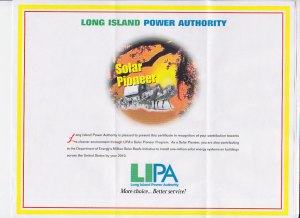This post is about LED replacement bulbs which may seem a little off-topic, but a lot of the themes are similar to that of solar energy: saving energy (and saving money) through alternative energy technology. I’ll entice you with the math first, and then you can decide whether you want to read on :-): the LED replacement bulbs I ended up getting (after sampling first) cost me $17.50 each (in quantity, all-in with shipping)… they will “pay for themselves” in 2.74 years (by saving me an estimated $6.39 per year), and then after that they will last a further 20 years during which I will yield an annual savings of $6.39 per bulb, which is 36.5% annually against the investment of $17.50.
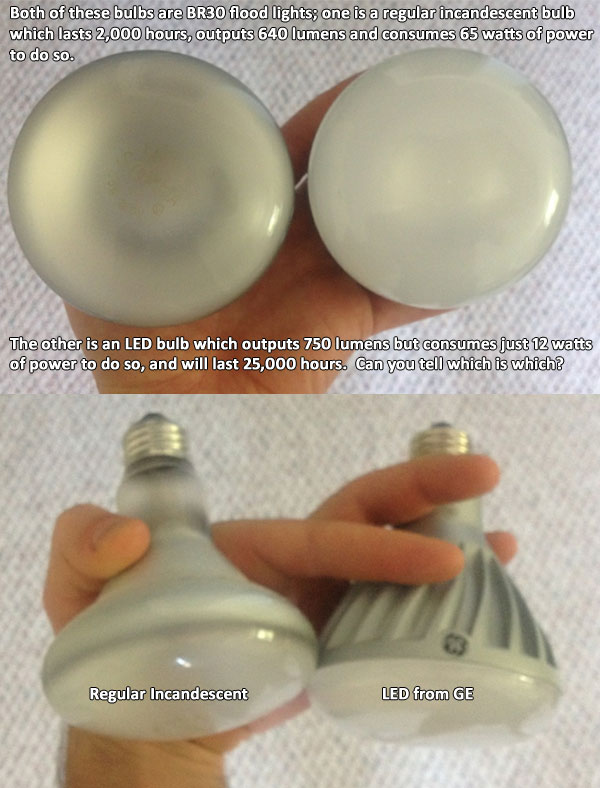
It should first be said that CFL bulbs have similar energy savings and cost less… on Amazon right now you can buy a dimmable 65-watt-equivalent CFL replacement bulb which consumes 15 watts and lasts 10,000 hours, for $13.99. But over the lifespan of the comparable LED, you’d buy 2.5 of these CFL’s (because the LED’s last 25,000 hours) for a total of $34.98. And there are some huge negatives to CFLs, here’s my biggest: (1) horrible dimming capability, they still stay way too bright at the lowest dimmer setting, and make a headache-inducing buzzing sound; (2) take a long time to warm up, so if you’re in and out of a room quickly, they will be dim the whole time; (3) there’s mercury in there.
LED’s by comparison have no mercury, are “instant”-on (they take a fraction of a second but then they are at full brightness), and the ones we tried dim beautifully and are completely silent. So for me, that’s a vast improvement over CFL’s. CFL’s were always something I didn’t really truly want, but felt I should get anyway; LED’s by comparison I actually like and want to have.
So here’s my full story on these LED replacement bulbs.
I was in Home Depot the other day in the light bulb section, when I saw that the bulb I was looking for was available in LED… My first reaction was to think that what I was looking at must be a bulb for a special LED high-hat system — because the last I had heard about LED bulbs (less than a year ago, from someone having them installed), the entire can was different and had to be done by an electrician. But later on at home I opened up the computer and researched it, and to my surprise, what I had stumbled upon in the store was actual true replacement light bulbs but based on LED technology… I could literally swap out an old bulb, for one of these new ones.
If this came as a surprise to me, I figure it may also be a surprise to others — and so I wanted to share the whole experience (hence this post) in the hopes that others might be inspired to shop for an LED bulb the next time an incandescent burns out (or, if like me you are enticed by this idea as an investment opportunity, to do some replacements).
Before buying anything, I read lots of reviews online. What I found caused me to want to steer clear of brands I had never heard of before — lots of people reporting problems with the lights behaving strangely under existing dimmers (instead of actually dimming they would flicker or otherwise malfunction). So I ended up sampling a few different bulbs from Philips and GE, figuring that the prominent names in the industry were most likely to function well (and they both did).
Our house had mostly BR30’s in the high-hats (65 watt incandescents throughout), and some BR40’s (85 watt incandescents). As of this writing (June 2012), Home Depot is currently selling a 12-watt BR30 LED bulb from Philips for $26.97, their 13-watt version for $39.99, and their BR40 also for $39.99 [don’t balk yet — there’s ways to get discounts, plus, LIPA currently offers a bulk-purchase rebate program at $15 each LED bulb if you buy 20+]. I tried each of these Philips bulbs from Home Depot, as well as a 12-watt BR30 LED from GE that I won on eBay at ~$20/each.
A good strategy for buying from Home Depot is to acquire gift cards on eBay or through one of the gift card exchange websites like Plastic Jungle… [The idea being that people who get gift cards and would rather have cash, are willing to accept less than face value for some quick cash… on Plastic Jungle right now you can get pretty much an unlimited dollar amount worth of cards for a 7% discount to face value, while on eBay I saw a few that sold for as much as an 11% discount.] Combined with a discount coupon you get in the mail or online (right now “HDJUNE” gets you 10% off up to $100 spent at homedepot.com), those prices can potentially be brought down with the gift card strategy to the neighborhood of $22 and $32, pre-rebate from LIPA.
Here’s the packaging for each of the bulbs I tried:
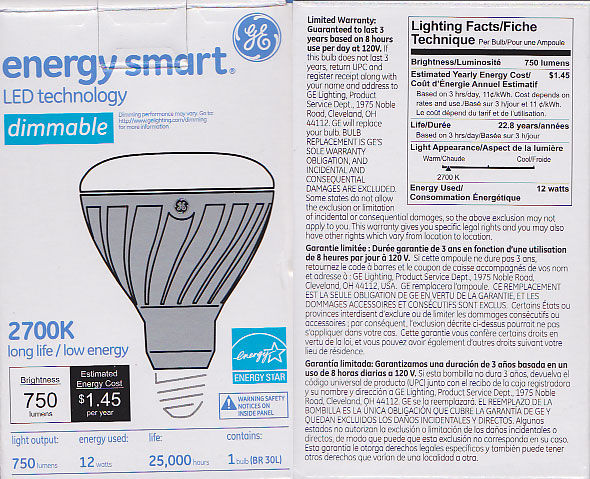
12-Watt LED BR30 Bulbs from GE; 750 Lumens (LED12DBR30/827)

13-watt BR30 LED Bulbs from Philips, 730 Lumens

12-watt LED Bulbs from Philips, 650 Lumens

Here’s the Philips BR40 LED bulbs, 14.5 watts, 800 lumens
There were two “winners” for us — the 13-watt BR30’s from Philips, and the 12-watt BR30’s from GE. Between these two, the GE bulbs, notably, output 750 lumens (vs. Philips at 730) while using about 8% less power. [As a side note, I read that LED’s were first discovered/developed at GE so I guess their superiority with the technology continues to this day]. At full power, the bulbs we liked best overall were the GE’s. At the lowest dimmer setting, we liked the Philips bulbs better — they get a little more dim compared to the GE’s. The other two Philips bulbs were “losers” but only because the 12-watt didn’t produce as much light (it was still OK just not as nice), and the 14.5-watt we expected a lot more light from compared to the 12-watt GE’s — an extra 2.5 watts working after all — but only got slightly more light. So the GE’s were the overall winner, and we also kept a few of the 13-watt Philips bulbs in bedrooms for the nicer dimmest light.
Here are PDF specs on the GE LED BR30 bulbs, and the Philips LED BR30 bulbs.

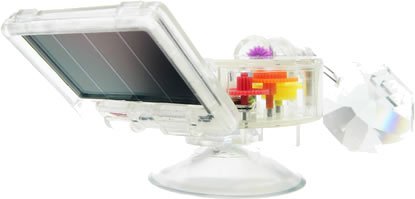 We originally received the “double” version as a gift several years ago, it was a lot of fun while it lasted but we must have knocked that thing to the floor by accident a half dozen times and after a series of successful repairs eventually one day it met its demise. But during its life we got a lot of enjoyment out of it, even though our apartment only got enough sun that it could be found spinning its prisms at only the right time of day for a short while.
We originally received the “double” version as a gift several years ago, it was a lot of fun while it lasted but we must have knocked that thing to the floor by accident a half dozen times and after a series of successful repairs eventually one day it met its demise. But during its life we got a lot of enjoyment out of it, even though our apartment only got enough sun that it could be found spinning its prisms at only the right time of day for a short while. 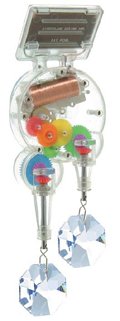 Fast forward to present, and we once again came across this gadget, seeing it in the gift shop of the Cradle of Aviation museum. We gave the “single” version a try and it performs wonderfully in our sunny house, spinning all afternoon placed on a South-facing window, and in the late afternoon placed in a West-facing window. The company that makes them is
Fast forward to present, and we once again came across this gadget, seeing it in the gift shop of the Cradle of Aviation museum. We gave the “single” version a try and it performs wonderfully in our sunny house, spinning all afternoon placed on a South-facing window, and in the late afternoon placed in a West-facing window. The company that makes them is 